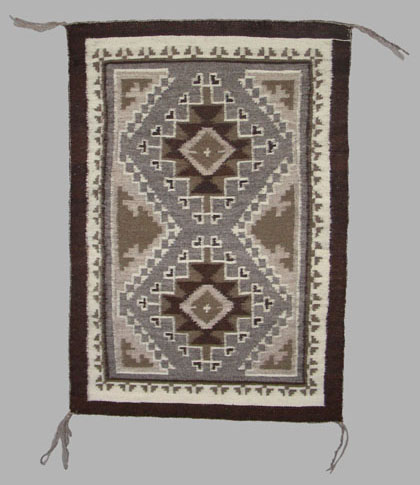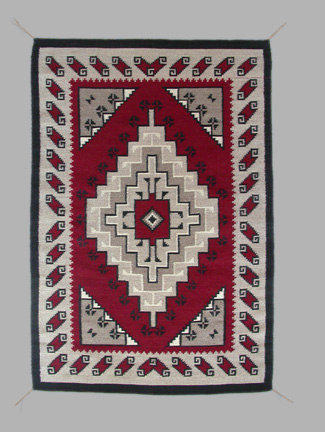

Made in England:
|
|||||||||||||||||||||||||

|
Margaret Shuffrey wraps the warp for a rug in a figure-8 pattern. |
Weaving a Navajo rug requires both technical and artistic skills. To begin, one warps the loom by wrapping a single, continuous warp strand back and forth between two wooden rods in a figure-8 pattern. With each turn, the tension on the warp must be uniform or else the finished rug will not lie flat. The weft yarns are woven over and under the warp yarns, and they, too, must be of uniform tension to insure a tight, flat weave and straight edges. The final wefts are often woven with needles, as there is no space to pass a shuttle. In some of the Shuffrey's finest tapestries, for example, there are 16 warps and 100 wefts per inch.

|
Tony Shuffrey's reproduction of the rug by Evelyn Curley shown on page 1. CAS 2007-0001-0021. |
The best Navajo weavers conceptualize and memorize complete designs in their heads and then execute them by counting the number of warps and wefts as they weave a design element. When they first began weaving Navajo-style rugs, the Shuffreys simply copied designs from photos. In fact, one of Tony's early rugs, completed in 1981, was a copy of the rug Evelyn Curley was finishing on their first visit to Hubbell Trading post.
As they became more accomplished, the Shuffreys adopted the Navajo technique of combining elements from different rugs into a new design. To transfer a design to the dimensions of their loom, they would draw one-quarter of the actual-sized design on graph paper, as a finished Navajo rug is generally a mirror image of itself from side to side and top to bottom.
From the beginning, Margaret and Tony wove the rugs for their own enjoyment, despite many requests by friends and others to buy them. They decided to weave at least one example of each regional style that has evolved on the Navajo Reservation. Most of these are named after particular trading posts or communities and are based on particular designs and/or colors.
 |
 |
 |
 |
Regional style rugs woven by the Shuffreys include (left to right): Multiple Pattern (CAS 2007-0001-0011), Wide Ruins (CAS 2007-0001-0010), Two Grey Hills (CAS 2007-0001-0030), and Ganado Red (CAS 2007-0001-0013). |
|||
As word spread locally about their weavings, the couple was asked to present a short talk about their project, first to a local weavers' guild, then to school children and other groups. Eventually, they signed up with a speakers' bureau, and by 2002, they had travelled all over England and Wales and presented more than 400 talks about Navajo history and culture, with particular emphasis on the weaving tradition, illustrated by their own weavings and photos. They urged their audiences to visit the American Southwest, particularly the Navajo, to experience the beauty of the land and the richness of the Navajo culture, both so very different from anything English.

|
Suzie Yazzie and family members admire one of Tony Shuffrey's Burntwater style rugs at their home in Monument Valley. CAS 2007-0001-0001. |
|
The Shuffreys eventually visited the Southwest nine more times after their first visit, and each time they took with them a photo album of the rugs they had completed, as well as a few of their smaller and most recent weavings. Predictably, these created quite a stir. At some of the trading posts, Navajo weavers would also be there at the same time and they, too, were amazed that a "bilagaana" (white people) couple, and from England no less, had woven such fine rugs. Several weavers even wanted to buy them.
![]()
|
|
|
|